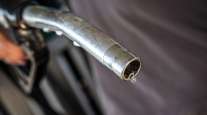Diesel Rises 0.5¢ to $4.132; Gasoline Inches Up 0.4¢
This story appears in the Sept. 17 print edition of Transport Topics.
Retail diesel prices in the United States rose 0.5 cent to $4.132 a gallon last week, the Department of Energy reported, for its 10th straight gain.
Commercial trucking’s main fuel has jumped 48.4 cents since July 9, leaving it 27 cents higher than a year earlier, DOE said after its Sept. 10 survey of fueling stations.
DOE also reported the average price for a gallon of regular gasoline edged up 0.4 cent to $3.847 a gallon. Gasoline has risen 41 cents over the past 10 weeks and is 18.6 cents higher than it was the same week in 2011.
In the prior week, diesel rose 3.8 cents while gasoline gained 6.7 cents.
“Hurricane Isaac appears to have impacted gasoline prices more than diesel, but the recent weekly price increase is still likely the result of the hurricane’s effects working their way through the market,” said Sean Hill, an analyst with DOE’s Energy Information Administration. “We don’t expect long-lasting effects, but the storm certainly contributed to price run-ups.”
Looking ahead, Hill said, “10 straight weeks of increase should come to an end soon, based on our outlook.”
“Hurricane Isaac was the biggest individual contributor to the price increase,” Trilby Lundberg, president of Lundberg Survey, said in an interview with Bloomberg News after announcing her survey found an 8-cent spike in gasoline prices over the previous two weeks.
However, Bill Day, a spokesman for Valero Energy Corp., said the oil industry was slowly increasing production each day.
A television station in Wyoming reported last week there has been a surge of truck drivers filling up in Cheyenne because of lower pump prices. Some truckers said they had driven as much as 50 miles out of their way to fill up. Others plan their route to include a fill-up in Cheyenne, the TV station said.
Diesel in Cheyenne was as low as $3.85 a gallon last week, according to wyoming gasprices.com.
“We fuel there frequently because of the low prices,” said Stan Anders, vice president of dry van hauler Anders Trucking Inc., Union Center, S.D. He said diesel prices are just as low in Rollins, Wyo., west of Cheyenne along Interstate 80. The area is the middle of the oil fracking industry.
Still, Anders said the diesel price increases are worrisome, and even though his dry van hauling company imposes fuel surcharges, they do not cover all of an increase.
Besides surcharges, the company has begun installing auxiliary power units and trailer skirts, and has already outfitted half the company’s 15-tractor fleet.
“At least we’ll have less idle time,” which saves fuel, Anders said.
In its latest short-term outlook, EIA projected the diesel average to remain above $4 through November, before falling to $3.91 in December. Although it said it expects diesel to average $3.96 a gallon for all of 2012, it expects diesel to average $3.73 in 2013.
EIA also said it expects the gasoline average to begin declining later in September, as the market recovers from Isaac and transitions to winter-grade specifications. The
latest forecast was $3.58 over the fourth quarter and $3.43 for 2013.
Bloomberg News reported oil supplies increased 1.99 million barrels to 359.1 million for the week ended Sept. 7, according to DOE.
Oil futures closed up $1.30 to $98.31 Sept. 13 on the New York Mercantile Exchange, the highest settlement price since May 4, Bloomberg News said. Oil closed at $97.01 a barrel on the New York Mercantile Exchange.
That was more than a $1 lower than before DOE’s report, which showed that stockpiles rose 1.99 million barrels in the week ended Sept. 7 to 359.1 million barrels.
DOE also said supplies of distillate fuel, a category that includes heating oil and diesel, increased 1.48 million barrels to 128.6 million, the highest level since April.
However, gasoline inventories fell 1.18 million barrels to 197.7 million, the lowest level since October 2008.




